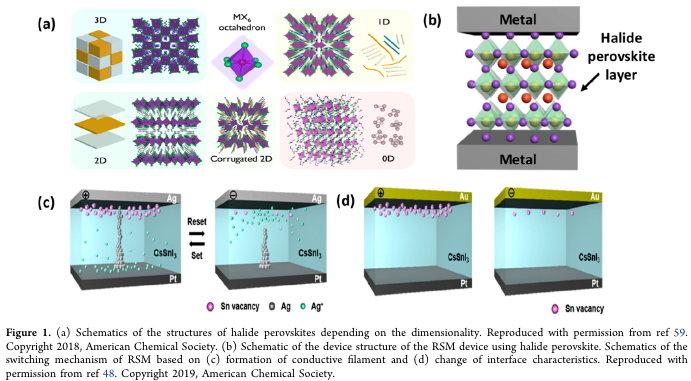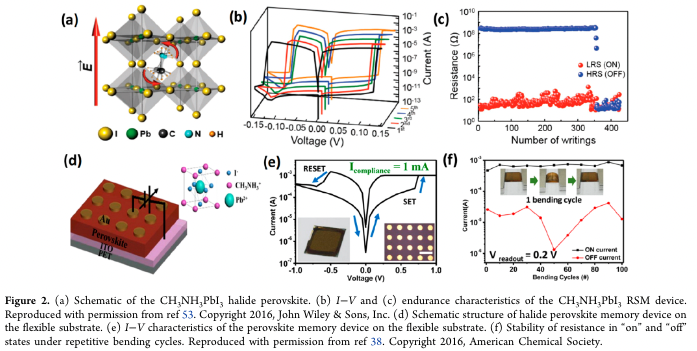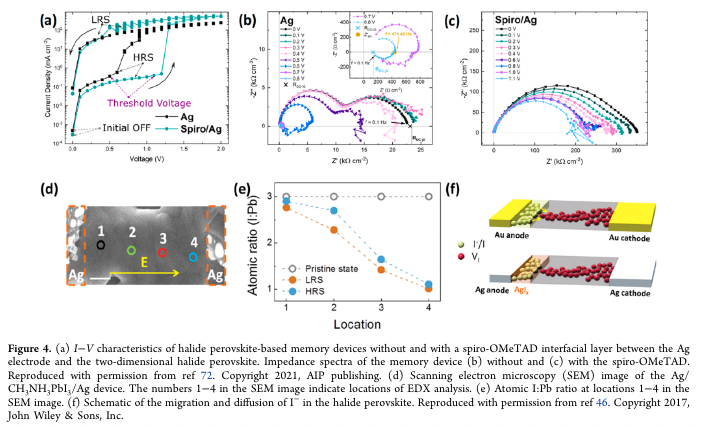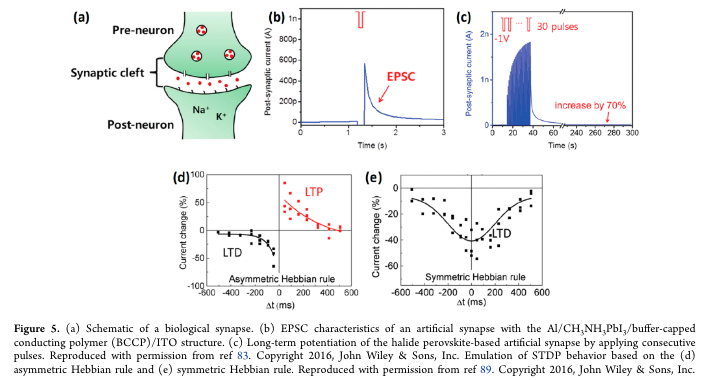Metal Halide Perovskite-Based Memristors for Emerging Memory Applications
(2022) - Youngjun Park, Jang-Sik Lee
- Link:
- DOI: 10.1021/acs.jpclett.2c01303
- Zotero Link: Metal Halide Perovskite-Based Memristors for Emerging Memory Applications
- Tags: #paper
- Cite Key: [@parkMetalHalidePerovskiteBased2022]
- Linked notes: Paper Annotations
Abstract
There is an increased demand for next-generation memory devices with high density and fast operation speed to replace conventional memory devices. Memristors are promising candidates for next-generation memory devices because of their scalability, stable data retention, low power consumption, and fast operation. Among the various types of memristors, halide perovskites exhibit potential as emerging materials for memristors by using hysteresis based on the movement of defects or ions in halide perovskites. However, research on the implementation of perovskite materials as memristors is in its early stages; some challenges and problems must be solved to enable the practical application of halide perovskites for next-generation memory devices. From this perspective, we highlight the recent progress in memristors that use halide perovskites. Moreover, we introduce a strategy to enhance the performance and analyze the operation mechanism of memory devices that use halide perovskites. Finally, we summarize the challenges in the development of device technology to use halide perovskites in next-generation memory devices.
Notes
Annotations (9/23/2022, 12:11:48 PM)
“The band gap of the perovskite, which affects the Schottky barrier height, is an essential parameter for the switching characteristics in RSM devices, such as the on/off ratio.31,32” (Park and Lee, 2022, p. 2)
“Accordingly, halide perovskite-based RSM devices have been investigated in recent years, demonstrating low-voltage operation, high on/off current ratio, multilevel characteristics, and fast operation speed.33-41 F” (Park and Lee, 2022, p. 2)
“Furthermore, encapsulation methods could be utilized to improve the stability of the perovskite-based RSM.” (Park and Lee, 2022, p. 2)
“The halide perovskite RSM device encapsulated by an oxide layer maintained characteristics for 30 days.42” (Park and Lee, 2022, p. 2)
“A conductive filament comprises metal atoms (e.g., Ag or Cu) supplied by a redox reaction at the active electrodes (e.g., Ag or Cu) that generate ions under an appropriate external bias.” (Park and Lee, 2022, p. 2)
“halide perovskite-based RSM, two filamentary-type switching mechanisms have been proposed for the resistive switching behavior in halide perovskite layers: defect migration in halide perovskite and conduction via metal filaments.45-48” (Park and Lee, 2022, p. 3)
“Defects composed of halide ions in halide perovskites have a low energy barrier to migration, allowing them to migrate easily.” (Park and Lee, 2022, p. 3)
“CH3NH3PbBr3 perovskite, the energy barrier for migration of Br- is 0.23 eV, which is lower than other defects of the barrier in perovskite.” (Park and Lee, 2022, p. 3)
“The change in resistance is related to the change in the Schottky barrier at the interface by an electric field.11,12” (Park and Lee, 2022, p. 3)
“device with a Au/CH3NH3PbI3-xClx/fluorine-doped tin oxide (FTO) structure exhibited bipolar resistive switching behavior (Figure 2a). The size of the top electrode (Au) was 50 × 50 𝜇m2. When the positive voltage bias was swept, the resistance changed from the HRS to the LRS; a subsequent negative voltage led to a change in the resistance to the HRS (Figure 2b). The fabricated device was operated for up to 100 cycles, and the device maintained its resistance state for 104 s (Figure 2c)” (Park and Lee, 2022, p. 3)
“memory device with a Ag/CH3NH3PbI3/Pt structure attained resistive switch- ing with a low operation voltage (<0.15 V). D” (Park and Lee, 2022, p. 3)
“Density functional theory (DFT) calculations inferred that device operation was possible because iodine vacancies in halide perovskites have a lower migration barrier than oxygen vacancies in oxide materials.” (Park and Lee, 2022, p. 3)
“A resistive switching layer of CH3NH3PbI3 was deposited on an indium tin oxide (ITO)-coated flexible substrate. The Au/CH3NH3PbI3/ITO structure memory device exhibited resistive switching (Figure 2d). Moreover, the device achieved stable switching operation under the application of tensile and compressive stresses. The bipolar resistive switching behavior under stress was similar to that when the device was not bent (Figure 2e). In addition, the device could stably operate for up to 100 consecutive bending cycles. (Figure 2f). Furthermore, a high yield of perovskite- based RSM was ach” (Park and Lee, 2022, p. 3)
“However, the use of halide perovskite-RSMs in practical applications requires improvement in properties, including the on/off ratio and endurance. Furthermore, the problem of degradation due to moisture in ambient air should be resolved. At present, the use of low-dimensional halide perovskites in memory devices is a promising approach for addressing these problems (Figure 3a).” (Park and Lee, 2022, p. 4)
“These 2D Ruddlseden-Popper halide perovskites comprise an inorganic layer between large organic cations and are stable in the air compared with 3D perovskites because the large cations can impede the infiltration of moisture.59” (Park and Lee, 2022, p. 4)
“In the HRS, the current decreased when the perovskite dimensionality was reduced from 3D to quasi- 2D to 2D, thereby increasing the on/off ratio.” (Park and Lee, 2022, p. 4)
“the on/off ratio on the dimensionality of halide perovskite is related to the high thermal activation energy and high Schottky barrier.45” (Park and Lee, 2022, p. 4)
“2D halide perovskite has large thermal activation energy, which may be related to the current in the HRS.34,45” (Park and Lee, 2022, p. 4)
“The thermal activation energy is associated with the trap states at the conduction band. Deep traps increase the activation energy at the HRS, which leads to a decrease in the current at the HRS and consequently increases the on/off ratio of the RSM devices.” (Park and Lee, 2022, p. 4)
“Endurance is another crucial feature in memory devices, and halide perovskite-based RSM devices exhibit limited endurance compared to oxide material-based memory devices.60” (Park and Lee, 2022, p. 4)
“A multilayer device used a heterojunction of 2D and 3D halide perovskites (Figure 3d), where the 2D halide perovskite (PEA2PbI4) was deposited onto the 3D halide perovskite (CH3NH3PbI3) by a solution process.” (Park and Lee, 2022, p. 4)
“The memory device based on the 2D/3D heterojunction achieved an endurance of 2700 cycles, which exceeded that of 3D halide perovskite- based memory without 2D halide perovskite (350 cycles) (Figure 3e).” (Park and Lee, 2022, p. 4)
“The 2D halide perovskite layer prevents the migration of Ag ions into the 3D perovskite film” (Park and Lee, 2022, p. 4)
“Furthermore, 2D halide perovskites have a high thermal conductivity,” (Park and Lee, 2022, p. 4)
“can control the breakdown of the filament. The high thermal energy of the 2D halide perovskite accelerated the thermal diffusion of Ag ions during the reset process, thereby improving the endurance properties of the memory device (Figure 3f). A” (Park and Lee, 2022, p. 5)
“A multilayer device with a structure of Al/Ag-doped ZnO/2D BA2PbBr4/Pt was proposed to improve the endurance properties of the RSM device. The Ag-doped ZnO layer served as a Ag-ion reservoir to control the concentration of Ag in the perovskite for filament formation. The memory device exhibited an endurance of 3 × 104 cycles, whereas the memory that used a Ag electrode instead of Ag-doped ZnO had an endurance of 400 cycles.” (Park and Lee, 2022, p. 5)
“A 2D halide perovskite- based RSM composed of (PEA)2(MA)n-1PbnI3n+1 and spiro- OMeTAD with a Ag electrode was investigated using impedance spectroscopy.72 The resistance in the RSM device with spiro-OMeTAD changed abruptly at a higher on/off ratio than that in a halide perovskite RSM device without spiro-” (Park and Lee, 2022, p. 5)
“However, a negative capacitance arc was not obtained when the spiro-OMeTAD interfacial layer was introduced between the halide perovskite and metal (Figure 4c). The negative capacitance was attributed to slow kinetics, such as migration and redistribution of ions at the interface between the halide perovskite and metal.” (Park and Lee, 2022, p. 5)
“the pristine state, the atomic I:Pb ratio was approximately 3:1, which proved to be consistent with the stoichiometry of CH3NH3PbI3. Following resistive switching operation, the ratio gradually decreased to ∼1 (Figure 4e). The change in the atomic I:Pb ratio was related to the migration of iodine ions during the resistive switching process. The ratio was below the stoichiometric value of 3 for the CH” (Park and Lee, 2022, p. 5)
“CH3NH3PbI3 film and considerably below the stoichiometric value of 1.01 near the cathode (at location 4), indicating that iodine vacancies are specific ionic species that contribute to the resistive switching operation.” (Park and Lee, 2022, p. 5)
“Artificial synapses that use halide perovskites achieve synaptic characteristics by controlling ion migration and filament formation in perovskite materi- als.28,29,50,81,82” (Park and Lee, 2022, p. 6)
“An artificial synapse that used halide perovskite was proposed using CH3NH3PbBr3 and a conducting polymer.83 The synapse functions in the halide perovskite- based artificial synapse were achieved by ion migration and trapping at the interface with electrical pulses. The Br- ions in the perovskite had a relatively low activation energy for migration (∼0.2 eV) compared to that of CH3NH3 + ions (∼0.8 eV). This difference indicated that Br- could migrate more easily than CH3NH3 + ions; therefore, the migration of Br- ions may contribute more to synaptic behavior than the migration of CH3NH3 +.” (Park and Lee, 2022, p. 6)
“Short-term plasticity is realized by the application of a low-amplitude pulse, which drives the movement of ions over a short distance. Therefore, the ions could be easily recovered to their initial state after the electrical signal was removed.” (Park and Lee, 2022, p. 6)
“Moreover, the artificial synapse emulated long-term plasticity when stimu- lated by high amplitude or a large number of pulses, which derived the ions sufficiently to become trapped at the interface and to be injected from perovskite to the polymer layer.
Following the removal of the applied pulses, some trapped or injected ions returned to the initial state; however, some ions remained in the trapped or injected state; these behaviors induced the long-term potentiation (Figure 5c)” (Park and Lee, 2022, p. 6)
“Artificial synapses that use halide perovskites can emulate spike-timing-” (Park and Lee, 2022, p. 6)
“dependent plasticity (STDP), which is a fundamental synaptic plasticity in biological neural networks. STDP is a response to the relative timing between spikes coming into pre- and postsynaptic neurons and can allow precise modulation of the connection strength between neurons (the device structure was Au/CH3NH3PbI3/PEDOT:PSS/ITO with a device size of 0.06 cm2). The synaptic weight was modulated by adjusting the timing of the pre- and postspike. The STDP characteristics of Hebbian learning were determined by controlling the” (Park and Lee, 2022, p. 7)
“the time interval between the two applied spikes (Figure 5d,e).” (Park and Lee, 2022, p. 7)
“However, the performance of halide perovskite-based RSM is still insufficient for commercialization; therefore, further research and develop- ment are required. In particular, reliability issues for stable device operation must be overcome, such as insufficient endurance. Halide perovskite RSM exhibits limited endurance properties compared with RSM using other materials.” (Park and Lee, 2022, p. 7)
“Recently, the endurance of halide perovskite RSM devices was advanced to approximately 106 cycles;62 however, further improvements are required to compete with the endurance of oxide memory devices, which can operate for >109 cycles.85” (Park and Lee, 2022, p. 7)
“Moreover, halide perovskite RSM does not have sufficient switching speed compared to RSM devices based on oxides, which can be operated using a subnanosecond pulse.” (Park and Lee, 2022, p. 7)
“A strategy for material design was recently proposed to improve the speed of halide perovskite RSM, which involved the use of first-principles calculations for high- throughput screening combined with experimental verifica- tions.36” (Park and Lee, 2022, p. 7)
“Moreover, the chemical instability of halide perovskites also impedes their use in memory devices. In particular, perovskites are known to degrade owing to moisture in ambient air, and this reaction can adversely affect the switching characteristics and reliability of halide perovskite RSM devices.86,87 The use of a passivation layer is a promising approach for addressing this problem.
Passivation using metal cations, ammonium salts, Lewis acids, and Lewis bases is employed to improve the stability of halide perovskites in solar cells.88 T” (Park and Lee, 2022, p. 7)




Using EDX to see the atomic ratio of I:Pb

B) EPSC: Excitatory Postsynaptic Current
C) Long-term plasticity. Increases 70% after removal of pulses